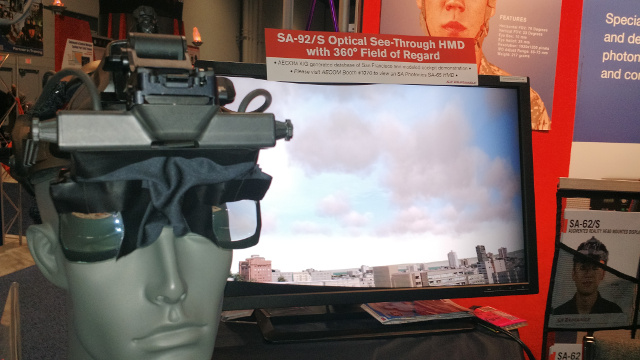I have just returned from the I/ITSEC 2015 trade show, North America’s big event for training and simulation. As expected, solutions continue to become more complex and more realistic, and displays play a key role – from collimated Level D flight simulators to virtual and augmented reality headsets.

The other major element of great simulation is the database and Image Generator (IG) hardware. These synthetic databases can be constructed many ways and are increasingly being based around game engines. They build upon many different types of databases like Landsat data, road data, 2D photography and 3D models of buildings and other items. We recorded a nice video with Boeing explaining this a little more.
Rockwell Collins announced a new WholeEarth database that can serve as a basis for creating more complex database – and save money by using this approach (see video and article – video is open, but articles are subscriber only). Rockwell Collins and about 20 other companies participated in a 3-day event at I/ITSEC called Operation Blended Warrior, which was a Live, Virtual, Constructed (LVC) demo of a “Black Swan” event involving land, air and sea assets (video).
Projection remains the only solution for immersive high end simulators and we looked at some trends here in our report. For example, we only saw one type of lamp-based projector on the show floor – all others are now LED or laser-phosphor based (video and article). We also noted an indifference to wide color gamuts except in some specialized simulation and training markets (article). We may also be seeing a trend toward more collaboration on these massive simulation projects. Even large companies often do not have all the technology in-house to bid on contracts, so they have to invest in development. Alternatively, others are putting together coalitions that bring together best of class solutions from multiple providers that offers lower risk and lower costs for the customer. This trend may indeed gain some traction.
In projection products, we saw a number of demos with perhaps the most compelling being those from JVC and Third Dimension Technologies. In the JVC booth, we saw an HDR simulation projector demo that had noticeable “pop” (video). While the simulation market has actually had projectors with incredible dynamic range, these capabilities have not often been used in the way that HDR is now being considered for TV. It will take time, but databases and displays will evolve to create images with more dynamic range.
JVC also had an impressive 8K e-Shift demo in collaboration with Boeing (video) that showed great detail, very low black levels and no motion smear. JVC pioneered the e-shift technology in projection and others now seem to be jumping on this bandwagon. In particular, TI has a new e-shift approach we described at CEDIA that is likely to find adoption in the simulation market, although no products were announced this year.
The light field display from Third Dimension Technologies was quite impressive (2D video, 3D video). We saw this last year and noticed a big improvement this year. The system was using 12 Optoma pico projectors but can support up to 22 projectors. It was used in a fast jet simulation to create a no-glasses 3D image that had very nice depth. The image is still a bit soft, but it is getting real close now. I can’t wait to see this next year.
In addition, we got updates on simulation activities from Sony (article), Digital Projection (article), Eyevis (article), Barco (article), Rockwell Collins, (article), Canon (article), Immersive Display Solutions (article), and Christie (video).
Virtual and Augmented Reality is also quite a hot topic in the simulation and training market with high end to low end solutions being tested and developed. At the high end are suppliers like SA Photonics which showed 62 and 92 degree FOV binocular HMDs that have very nice image quality (article).

But lower cost headsets are definitely gaining a lot of attention. For example, we looked at the new rigged BT-2000 binocular AR headset from Epson which they demonstrated in applications including with a new gesture partner, plus control of drones, medical surgery visualization and virtual theme park uses (article).
Oculus was there as well and we got to try their CV1 (Consumer Version 1) HMD which is slated for Q2’16 availability. The image quality is very good, although pixels are visible and there is some aliasing. However, smear and latency were very low and quite acceptable. Pricing is still TBD (article).

Sensics was talking about their activities with OSVR (Open Source Virtual reality) with game developer Razor and its use in the simulation market (article). General Dynamics described their fire fighting VR solution in development (article). Rockwell Collins collaborated with WorldViz to show off training applications in VR (video).
I/ITSEC is a great show to understand the key trends and see the latest products for training and simulation. The needs are quite specialized and drive development of some technologies – which can then be repurposed for other markets. We will be back again next year. – CC

